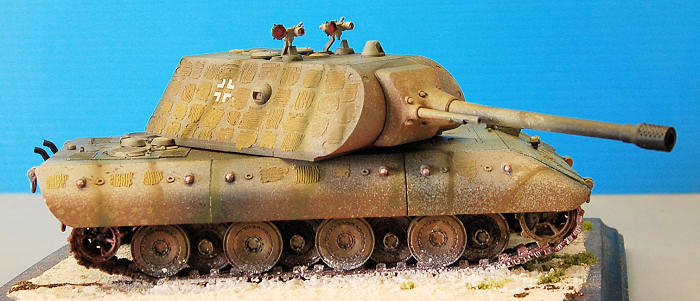
| KIT #: | 6011X |
| PRICE: | $39.00 |
| DECALS: | One option |
| REVIEWER: | Greg Ewald |
| NOTES: | Huge tank model, well molded , very little detail. 12”x5”x 4.5” |

| HISTORY |
This
is one of Uncle Adolph’s craziest schemes, the “super heavy” tank. With a turret
that alone is almost the size of a
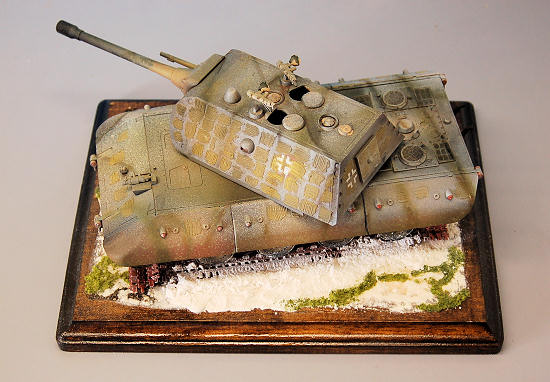 The
Russians had brought out the heavy KV-1, and it had certainly done some damage
to the lighter Panzers, but the mud of the snowmelt would have proven to be a
real pain in the tank for these 100 tons (plus) vehicles on the eastern front.
The
Russians had brought out the heavy KV-1, and it had certainly done some damage
to the lighter Panzers, but the mud of the snowmelt would have proven to be a
real pain in the tank for these 100 tons (plus) vehicles on the eastern front.
Idealistically, these huge armored tanks would have been used to repel the allied invasion on the French coast, at least, that was Rommel’s idea (hey, a sane German general?) As floating turrets, so to speak, the land cruiser Maus could have had a tremendous impact on the incoming armada. Luckily, they were very poorly engineered, underpowered, and overweight. All in all, a very silly design that sucked out money of the German corps to the benefit of the Allies. The E-100 was just crazy.
Ah yes, another wrecked Nazi tank, my favourite!
April, 1944 near
Oberlieutenant Reichman was furious. He stormed
around the new tank, a hulking beast of metal, as his crew busily loaded in the
ammunition.
A light drizzle was melting the winter snow, and the
water hissed as it hit the hot engine manifolds. The damn thing had broken down
again.
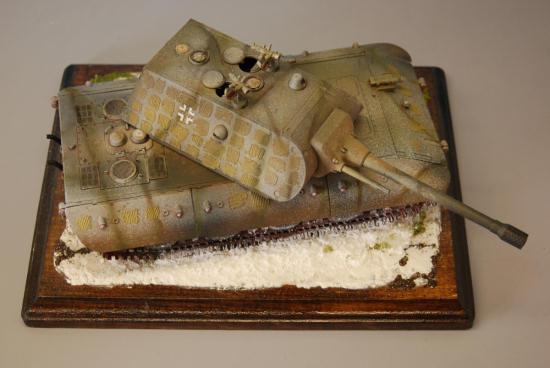 “This thing is a piece of junk!” he swore, and
kicked at a tread. His beloved King Tiger was far superior and had never failed
him, why he had been relegated to command a heavy platoon of these landcruisers
must be some sort of punishment from high command. Whether Hitler liked them or
not, the Maus was just inefficient.
“This thing is a piece of junk!” he swore, and
kicked at a tread. His beloved King Tiger was far superior and had never failed
him, why he had been relegated to command a heavy platoon of these landcruisers
must be some sort of punishment from high command. Whether Hitler liked them or
not, the Maus was just inefficient.
To make it worse, they had to be plastered with
zimmerit in the field, since the bloody allies had bombed out the production
facility, and they had only given him 5 cans of the stuff per tank! 5 cans? It
wouldn’t have covered a Panther!
Gunther leaned down from the high turret, “
Commander, there is a report of an inbound air attack.” His mouth twitched, and
his face showed the same strain as the rest of the crew, deeply lined with
fatigue. “The Luftwaffe was unable to hold them back.”
“Damn airjockeys!” They got the best food, the best
barracks, the best women. Here he was, a decorated tank commander, stuck in the
snow again with a hulking piece of metal that was only good as a target.
The loud rattling of his second tank came from the
woods, and it slowly pulled up to a parallel position. The smell of fuel wafted
out of the hatches as his second in command waved to him.
“Again?” was all he said, a look of disgust on his
dirty face.
“I’m telling you, “ Reichman snorted, “these things
are just ridiculous.” He glared around the empty field, there were nothing but
corpses and ruined T-34’s to see. His night fighting equipped tank, a vampire,
was a sitting duck. He yelled to Gunther, “ Set the charges, we’re leaving this
one here!”
His crew clambered aboard the number two tank, and they rumbled into the cover of the woods. Hopefully, this other piece of junk wouldn’t break down before the allied ground attack aircraft arrived. Hopefully.
| THE KIT |
Very little flash, and an incredibly tight fit between the parts. The molding is so superb as to be almost unreal, especially the turret. Figures of SS troops are included with the tank, but no tank crew. (?)
Unusually, there are very few parts to this kit, unless you add in the link and length tracks. It would have been nice to have turned barrels for the main guns rather than the half-n-half plastic jobs, but with a bit of puttysandrepeat, they turn out O.K.
The metal etching is very well done, and with some cleanup, looks fantastic.
Quite a lot of the detail that is well done is covered up by armor or covers, which is somewhat sad, though it does open up the door for a number of after market items or the intrepid scratchbuilder.
| CONSTRUCTION |
I started this beast
by washing the whole thing in soapy water, then after it was dry, I primed it
with Krylon gray auto primer. A
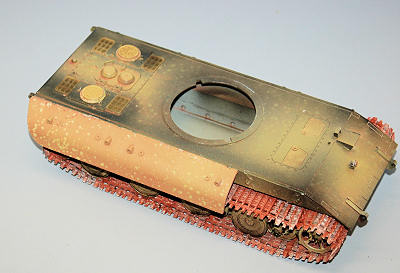 light
coat of flat aluminum followed, and was let to air dry in our lovely
light
coat of flat aluminum followed, and was let to air dry in our lovely
Bogies: The fit of the painted styrene is so tight that you have to tap on the bogie frames with a small hammer, or in my case, a large X-Acto knife.
Turret: The massive barrels of this tank are well done, go together easily, and require just a little bit of psr. The turret itself is magnificent, how it was molded so perfectly it is actually on of the questions I have for modern model companies. How the heck did you do that?
The turret hatches are also well done, but since we are doing the “nightfighter”, make sure that you glue the command hatches to the rear, as the hatches will interfere with the Uhu style light amplification gear.
The kit metal etch is wonderful, I would recommend annealing (heating and then cooling down rapidly) the entire fret. I didn’t, and really regret it.
| TRACKS |
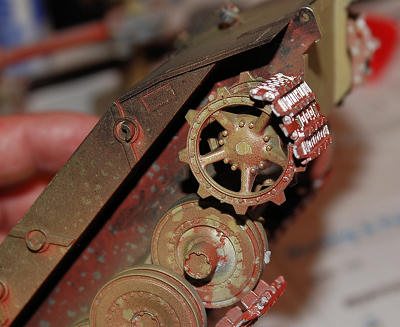 If you
haven’t used link and length tracks, this is a good starter kit, as the tracks
are so huge. I like to glue the first series to the spoke driving wheel, then
rotate it around to meet the bottom, it saves a lot of grief. Using AC glue,
just add on each separate piece slowly, you can work on one side, and then the
other, just keep on flipping the beast!
Once again, the parts fit together tightly, so take
your time and work slowly. I find that about 30-45 minutes of track assembly is
good enough for me, then you need a cold one, and a bit of a stroll. Repeat.
Over and over and over. Link and length can try your soul.
If you
haven’t used link and length tracks, this is a good starter kit, as the tracks
are so huge. I like to glue the first series to the spoke driving wheel, then
rotate it around to meet the bottom, it saves a lot of grief. Using AC glue,
just add on each separate piece slowly, you can work on one side, and then the
other, just keep on flipping the beast!
Once again, the parts fit together tightly, so take
your time and work slowly. I find that about 30-45 minutes of track assembly is
good enough for me, then you need a cold one, and a bit of a stroll. Repeat.
Over and over and over. Link and length can try your soul.
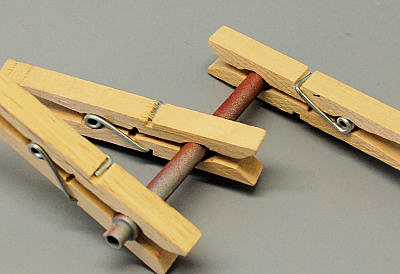 opportunity
to somehow have a visible line of sight. Squint. Hard. Hey, these things are
about ½” long. The clear bits are very well molded, but the location marks are
pretty much invisible. Like Wonder Woman’s jet, but without the pretty pointy
parts.
opportunity
to somehow have a visible line of sight. Squint. Hard. Hey, these things are
about ½” long. The clear bits are very well molded, but the location marks are
pretty much invisible. Like Wonder Woman’s jet, but without the pretty pointy
parts.
| COLORS & MARKINGS |
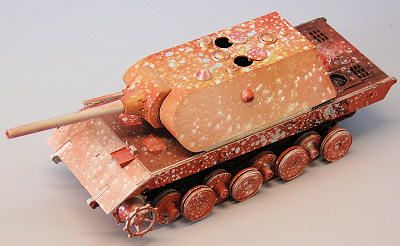 Inspired
by another commentary about a different build, I decided to once again try the
unusual. spaghetti. The entire frame was primed, sprayed in flat aluminium,
salted, and then primed in
Krylon red. Wash off the salt with a 3M pad, and
then hit it with a light spray of Africa Desert Yellow (Dark Tan), thinned down
about 70 percent.
Inspired
by another commentary about a different build, I decided to once again try the
unusual. spaghetti. The entire frame was primed, sprayed in flat aluminium,
salted, and then primed in
Krylon red. Wash off the salt with a 3M pad, and
then hit it with a light spray of Africa Desert Yellow (Dark Tan), thinned down
about 70 percent.
Silver and black Sharpie pens were used on the bogies for the
steel look, be sure to not spray over these with any sort of clear gloss, as it
wil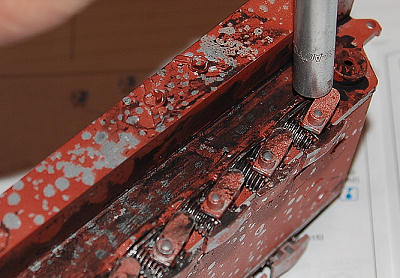 l
make the ink run.
l
make the ink run.
I applied the theoretical field applied zimmerit using a tinted paste with a bit of razor saw, and set the whole affair off to the side to dry.
Wet spaghetti is draped over the model, and allowed to dry for about one hour, then a light spray of white is applied for the winter camo. Allow the whitewash to dry overnight, and then gently remove the pasta. Viola! Yeah, well, it didn’t work.
I used a typical sludge wash for the
wheels, but varied the exhaust marks by usin g
the detail
Hansa
airbrush with some ink and black acrylic.
g
the detail
Hansa
airbrush with some ink and black acrylic.
Since the Maus never really saw service, the sky is the limit for colour patterns. Tell the jmn’s to get bent if they give you any grief .I did stick with the typical 1944 series of paints, just to be normal. Chuckle.
Turns out that using wheat pasta, which is what we had in the pantry, is just about useless. Perhaps I will try normal pasta for the next build. Wheat spaghetti may be healthier, but it sucks for masking. Hey, it was an experiment. Using the Badger Hybrid, I put in some green line camo, and a wash of black.
I love building wrecked German tanks, it fills a void in my spirit. The backstory of this huge Maus sitting on an open snowy plain was just too good to resist. The base came from Michael’s craft store, and after staining, a thin coat of wood glue was applied. Powder it with some drywall compound mix ( I like the 20 minute set stuff), and a little bit of sugar, and you have snow. Some greenery was added from Woodland Scenics, and I had a plot for my tank (my tank) to sitz on. The undone treads were added after the bulk of the painting had been accomplished.
| CONCLUSIONS |
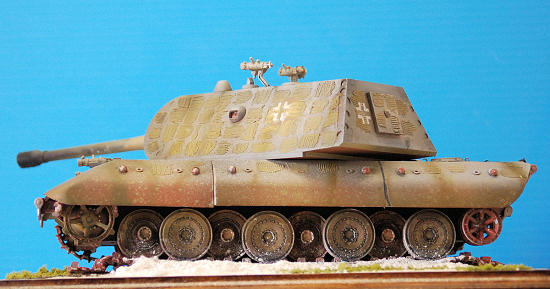
Yes, some of you purists will be frothing at the mouth by now. The E-100 and the Maus are not exactly the same, but are so close that I think we can just blink a little. Neither one made it to combat anyway, and the parts were intermingled after the war.
| REFERENCES |
Greg Ewald
May 2008
Copyright ModelingMadness.com. All rights reserved.
If you would like your product reviewed fairly and fairly quickly, please contact the editor or see other details in the Note to Contributors.